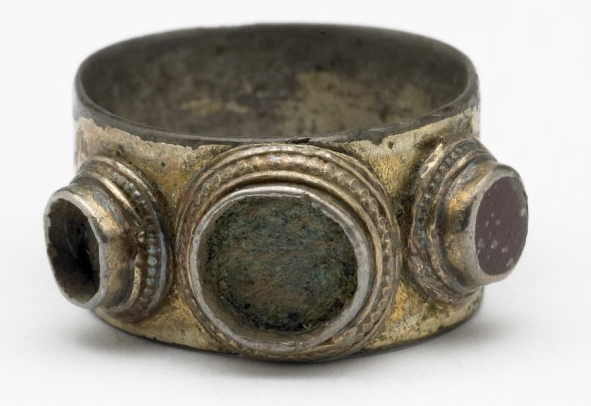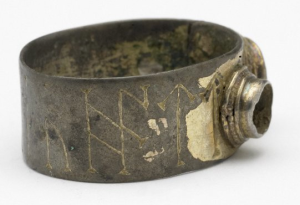
source: The British Museum
In 1993 whilst digging trenches for a house on Wheatley Hill, Durham, a silver alloy ring was uncovered. Dating to the 8th century AD, the ring is a band of silver with remnants of a gilded surface. Within beaded collars are three riveted bosses, of which one still holds a red glass inset. On the back of the hoop is the old English runic inscription [H]RING IC HATT [æ], translating as, “I am called ring”[1]. Elements of personification are a common aspect of Anglo-Saxon inscriptions, giving a voice, a level of consciousness, and a sense of personal possession to inanimate items.

Source: The British Museum
The Wheatley Hill ring is one of approximately twenty-seven late Anglo-Saxon finger-rings engraved with an inscription. This number is approximate due to some rings having been lost, deteriorated, or bearing illegible lettering. The first and last runic letters on the Wheatley Hill ring are covered up by two of the bosses, indicating that the inscription was engraved before the glass insets were applied. Even so, it can be steadily assumed that these letters are the runic H in the word hring, and the last being æ in the word for “called” [2].

source: The British Museum
Mentioned frequently in Old English riddles, hring refers to a valuable object of gold, usually inscribed with a religious text, and oftentimes with a personal name [3]. These may refer solely to finger-rings themselves, or to any hooped item such as a bracelet or earring. The action of deliberately putting the objects name on the object itself is unique to the Wheatley Hill ring. Where other rings use the pronouns me, my, or I along with a personal name, the Wheatley Hill ring identifies and establishes itself as a hring. The purpose of such an action is uncertain. The artist may have meant to endow a comedic attitude to the ring, or simply state the obvious. It may also have been a scrap piece for the creator to practice their writing, with the later application of the glass insets taking the attention away from the message and giving the ring a new angle and perspective.

Illustration of the decorative features on the Wheatley Hill ring. Source: The Viking Rune
The runic inscription is written in the Anglo-Saxon “Futhorc” alphabet, a 33-letter modification of the continental 24-letter “Elder Futhark,” of which the Anglo-Saxons brought to Britain in the 5th century [4]. Futhorc itself means “alphabet,” and corresponds to the first six letters of f, u, th, o, r, and c. The runes on the ring are clear, correlating precisely to the futhorc letters in the image below. On the third rune from the right in the inscription, the a in hatt is combined with the h to form an extra feature.

Source: Simon Ager at Omniglot.com
Where the majority of Anglo-Saxon finger-rings have inscriptions with names identifying personal ownership or affiliation, the Wheatley Hill ring is unique in that it identifies itself as an object. No other ring known as of yet has this characteristic. An antler bone found in Brandon, England has a slightly similar runic inscription of WOHS WILDUM DE[O]RAN, roughly translated as “I/It grew on a wild beast” [6]. A few artefacts from Scandinavia are comparable, such as a bone fragment from Lund, Sweden which has the runic inscription “this is bone, this is bone,” and an instrument from Trondheim, Norway states that it is a “lyre” [6]. Although not alone in its simplistic and straight-to-the-point declaration, the Wheatley Hill ring stands alone in its Anglo-Saxon finger-ring family. Perhaps inscriptions in the Anglo-Saxon world were believed to give inanimate objects magical powers, as is evident on a few finger-rings with runes and symbols comprising gibberish phrases meant to be amuletic charms. Perhaps giving this ring from Wheatley Hill an inscription gave it a consciousness and soul of its own. Or perhaps it was simply an act of boredom by the inscriber, who desired to practice his or her writing. Regardless of the story behind the Wheatley Hill ring, it is a beautiful example of Anglo-Saxon artistry, literacy, and individual merit. References: 1. Johnson, C. 2014. A Typological Assessment of Late Anglo-Saxon and Viking-Age Finger-Rings from Britain Dating from AD 600-1100 (Unpublished master’s thesis). University College London. London, UK. 2. Page, R.I. 1997. An Anglo-Saxon Runic Ring. Nytt Om Runer, Vol. 12, pp. 11-12. 3. Okasha, E. 2003. Anglo-Saxon Inscribed Rings. Leeds Studies in English, n.s. 34, pp. 29-45. 4. Lo, L. Ancient Scripts: Futhark. http://www.ancientscripts.com/futhark.html 5. Ager, S. Old English/Anglo-Saxon. http://www.omniglot.com/writing/oldenglish.htm 6. Page, R.I. 2006. An Introduction to English Runes. United Kingdom: Boydell Press.